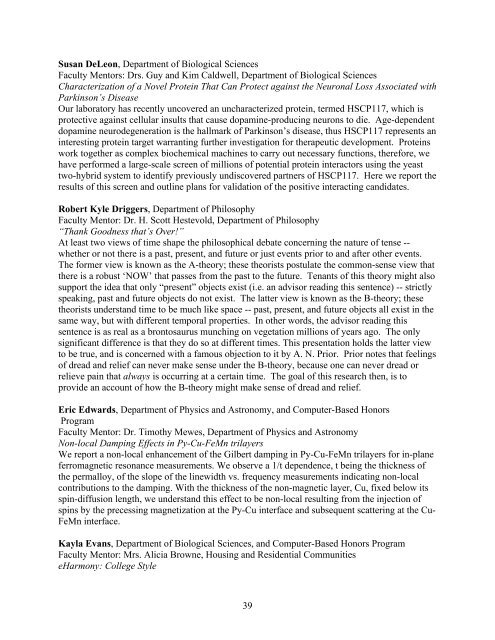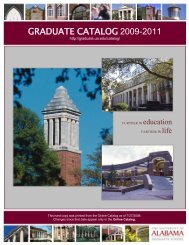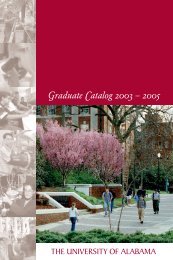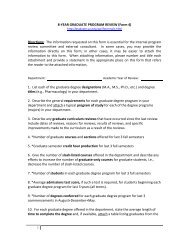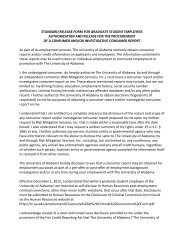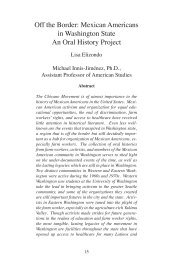Susan DeLeon, Department of Biological SciencesFaculty Mentors: Drs. Guy and Kim Caldwell, Department of Biological SciencesCharacterization of a Novel Protein That Can Protect against the Neuronal Loss Associated withParkinson’s DiseaseOur laboratory has recently uncovered an uncharacterized protein, termed HSCP117, which isprotective against cellular insults that cause dopamine-producing neurons to die. Age-dependentdopamine neurodegeneration is the hallmark of Parkinson’s disease, thus HSCP117 represents aninteresting protein target warranting further investigation for therapeutic development. Proteinswork together as complex biochemical machines to carry out necessary functions, therefore, wehave performed a large-scale screen of millions of potential protein interactors using the yeasttwo-hybrid system to identify previously undiscovered partners of HSCP117. Here we report theresults of this screen and outline plans for validation of the positive interacting candidates.Robert Kyle Driggers, Department of PhilosophyFaculty Mentor: Dr. H. Scott Hestevold, Department of Philosophy“Thank Goodness that’s Over!”At least two views of time shape the philosophical debate concerning the nature of tense --whether or not there is a past, present, and future or just events prior to and after other events.<strong>The</strong> former view is known as the A-theory; these theorists postulate the common-sense view thatthere is a robust ‘NOW’ that passes from the past to the future. Tenants of this theory might alsosupport the idea that only “present” objects exist (i.e. an advisor reading this sentence) -- strictlyspeaking, past and future objects do not exist. <strong>The</strong> latter view is known as the B-theory; thesetheorists understand time to be much like space -- past, present, and future objects all exist in thesame way, but with different temporal properties. In other words, the advisor reading thissentence is as real as a brontosaurus munching on vegetation millions of years ago. <strong>The</strong> onlysignificant difference is that they do so at different times. This presentation holds the latter viewto be true, and is concerned with a famous objection to it by A. N. Prior. Prior notes that feelingsof dread and relief can never make sense under the B-theory, because one can never dread orrelieve pain that always is occurring at a certain time. <strong>The</strong> goal of this research then, is toprovide an account of how the B-theory might make sense of dread and relief.Eric Edwards, Department of Physics and Astronomy, and Computer-Based HonorsProgramFaculty Mentor: Dr. Timothy Mewes, Department of Physics and AstronomyNon-local Damping Effects in Py-Cu-FeMn trilayersWe report a non-local enhancement of the Gilbert damping in Py-Cu-FeMn trilayers for in-planeferromagnetic resonance measurements. We observe a 1/t dependence, t being the thickness ofthe permalloy, of the slope of the linewidth vs. frequency measurements indicating non-localcontributions to the damping. With the thickness of the non-magnetic layer, Cu, fixed below itsspin-diffusion length, we understand this effect to be non-local resulting from the injection ofspins by the precessing magnetization at the Py-Cu interface and subsequent scattering at the Cu-FeMn interface.Kayla Evans, Department of Biological Sciences, and Computer-Based Honors ProgramFaculty Mentor: Mrs. Alicia Browne, Housing and Residential CommunitieseHarmony: College Style39
A student’s overall college experience can be influenced by many different factors, including hisor her living situation. A website designed to match students with potential roommates based onthe compatibility of key personality traits, habits, and schedules could aid both new and returningcollege students in their search for roommates.Matthew Ferguson, Department of Chemical and Biological Engineering, and Computer-BasedHonors ProgramFaculty Mentor: Dr. Joseph Weber, Department of GeographyIntegrating Google SketchUp and Google Earth to Create a 3-Dimensional Campus Map<strong>The</strong> goal of our project was to model the <strong>University</strong> of Alabama campus in Google SketchUp, a3-D modeling program. Google Earth, an overhead map viewer, was then used to correctlyposition the campus buildings onto a land map of the <strong>University</strong>. <strong>The</strong> second phase of the projectinvolves taking our existing models and modeling the floor plans within the building, in thehopes of creating a virtual, 3-D tour of the campus.Danielle Jean Fortner, Department of Telecommunication and FilmFaculty Mentor: Dr. Pamela Tran, Department of Telecommunication and FilmShooting Club, Barbershop QuartetTV packages aired on WVUA-TV and chosen to represent our school in the national HearstFoundation Broadcast News Competition. <strong>The</strong> Shoot Club piece is on a little publicized sportand the Barbershop Quartet piece in on the unusual hobby of a local lawyer.Stacey Fox, Department of Biological SciencesFaculty Mentor: Dr. Kim Caldwell, Department of Biological SciencesMechanistic Analysis of torsinA Function by RNAiCells are continuously exposed to a variety of external and internal stressors. Occasionally,when natural defense mechanisms do not combat these cellular insults, disease develops. Forexample, the accumulation of improperly folded proteins in the endoplasmic reticulum (ER)triggers an adaptive cellular process termed the unfolded protein response (UPR). Usingselective gene knockdown by RNAi we have discovered that the molecular chaperone proteintorsinA is involved in maintaining ER homeostasis via the UPR. Notably, mutant torsinA,responsible for the human movement disorder dystonia, cannot assist in cellular stressmanagement. <strong>The</strong>se data have implications for diseases associated with protein misfolding.Ericka Lorraine Gibbs, Department of Health ScienceFaculty Mentor: Ms. Michelle Darst, Department of Health Science<strong>The</strong> Quality of Life in Traumatic Brain Injuries and Its Effect in Society for the IndividualBackground: Annually, 1.5 million Americans suffer a Traumatic Brain Injury(TBI)(CDC,2006). <strong>The</strong> purpose of this discussion is to enlighten and educate on the seriousness andprevalence of TBIs. Methods: Reputable health sources were reviewed to gain insight into thequality of life of individuals with TBI. Results: <strong>The</strong> findings exemplify the pathways, copingskills, and permanent lifestyle changes of individuals with a TBI. Conclusions: Further researchof individuals with TBIs is warranted in order to be aware of the causes and impact of TBI, tocreate prevention programs, and to assist the emotional and behavioral changes associated withTBI.40
- Page 1 and 2: THE UNIVERISTY OF ALABAMAFirst Annu
- Page 3 and 4: Office of the Provostand Vice Presi
- Page 5 and 6: Awards Presentations, Ferguson Stud
- Page 7 and 8: 3:30Mary Margaret Randall, New Coll
- Page 9 and 10: Room 3052:00Harold William Bloom II
- Page 11: 3:00Britton O’Shields, Department
- Page 14 and 15: 11BCatherine Qualls, Department of
- Page 16 and 17: 19BSusan DeLeon, Department of Biol
- Page 19 and 20: 31BMaxwell Thompson, Department of
- Page 21 and 22: 37BBradford Patterson, Department o
- Page 23 and 24: 41BAmanda Hall, Programs in Element
- Page 25 and 26: 48BCarter Slappey, Computer-Based H
- Page 27 and 28: School of NursingOral PresentationR
- Page 29 and 30: Oral and Poster Presentations Abstr
- Page 31 and 32: thermophila NP1, a temperature-sens
- Page 33 and 34: can access this information. The pr
- Page 35 and 36: Caliste Boswell, Department of Huma
- Page 37 and 38: This imaging will help us evaluate
- Page 39: Jason Crowell and Strud Tutwiler, D
- Page 43 and 44: Heather Griffin, Department of Clot
- Page 45 and 46: Travis Hartin, Department of Psycho
- Page 47 and 48: trends in homicide to develop a det
- Page 49 and 50: performed with density functional t
- Page 51 and 52: Jonathan Lanctot, Department of Civ
- Page 53 and 54: Through the implementation of onlin
- Page 55 and 56: Phone, face to face, or internet- w
- Page 57 and 58: in marine biology, my research has
- Page 59 and 60: was thrust over the Bourne subterra
- Page 61 and 62: Kimberly Ray, Department of Kinesio
- Page 63 and 64: opportunities in our community. The
- Page 65 and 66: efficacy had some impact on the lik
- Page 67 and 68: Savannah Watts, Department of Chemi
- Page 69 and 70: India D. Williams, New CollegeFacul
- Page 71 and 72: Nicolette Corbin, Department of Che
- Page 73 and 74: Andrea Miller, Department of Human
- Page 75 and 76: Faculty MentorsDr. Rebecca Allen, D
- Page 77 and 78: Dr. Lonnie Strickland, Department o


